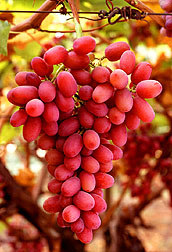This page has been archived and is being provided for reference purposes only. The page is no longer being updated, and therefore, links on the page may be invalid.
|
|
Mouth-Watering New FruitsBy Marcia WoodAugust 29, 1997 Flavorful new peaches and nectarines from California should please growers and shoppers alike. The treefruits are the latest from the Horticultural Crops Research Laboratory in Fresno, where scientists have produced 26 flavorful new fruits in the past 25 years. The lab is part of USDA’s Agricultural Research Service. The Fresno lab’s most recent varieties include Spring Baby, Spring Gem and Autumn Red peaches, and Crimson Baby and September Free nectarines. Spring Baby peaches are deliciously ripe by the first week of May. Spring Gems ripen at the end of May. Cuttings of the new fruits are available to growers. Consumers may begin seeing them at markets in about 5 years. “Embryo rescue” techniques perfected by the Fresno scientists enable them to produce fruits that ripen earlier in spring than before--a welcome treat for winter-weary consumers. Embryos from early-season parents are usually too small to survive on their own, so researchers rescue them from the developing stone, or pit. In the laboratory, the embryos thrive on a gel-like bed of nutrients until they grow into plants. For a mid-August harvest, the researchers produced Autumn Red peach. Sweet and juicy, Autumn Red meets the demand for “fully blushed” peaches--yellow skin with an attractive, dark red tint. Crimson Baby nectarines, ready to pick in late May, are large and round--unaffected by size and shape problems that often ruin other early-season nectarines. At the end of the season--about the end of August or first week of September--growers can harvest pleasantly firm, top-quality September Free nectarines. In orchard trials, trees bearing the red-blushed fruit were consistently vigorous and productive. The August issue of the agency’s magazine Agricultural Researchcarries an in-depth article on the new fruits. The story also is on the World Wide Web at: /is/AR/archive/aug97/fruit0897.htm Scientific contact: David W. Ramming, USDA-ARS Horticultural Crops Research Laboratory, Fresno, Calif., phone (209) 453-3061, fax (209) 453-3088, d1ramm@qnis.net |

